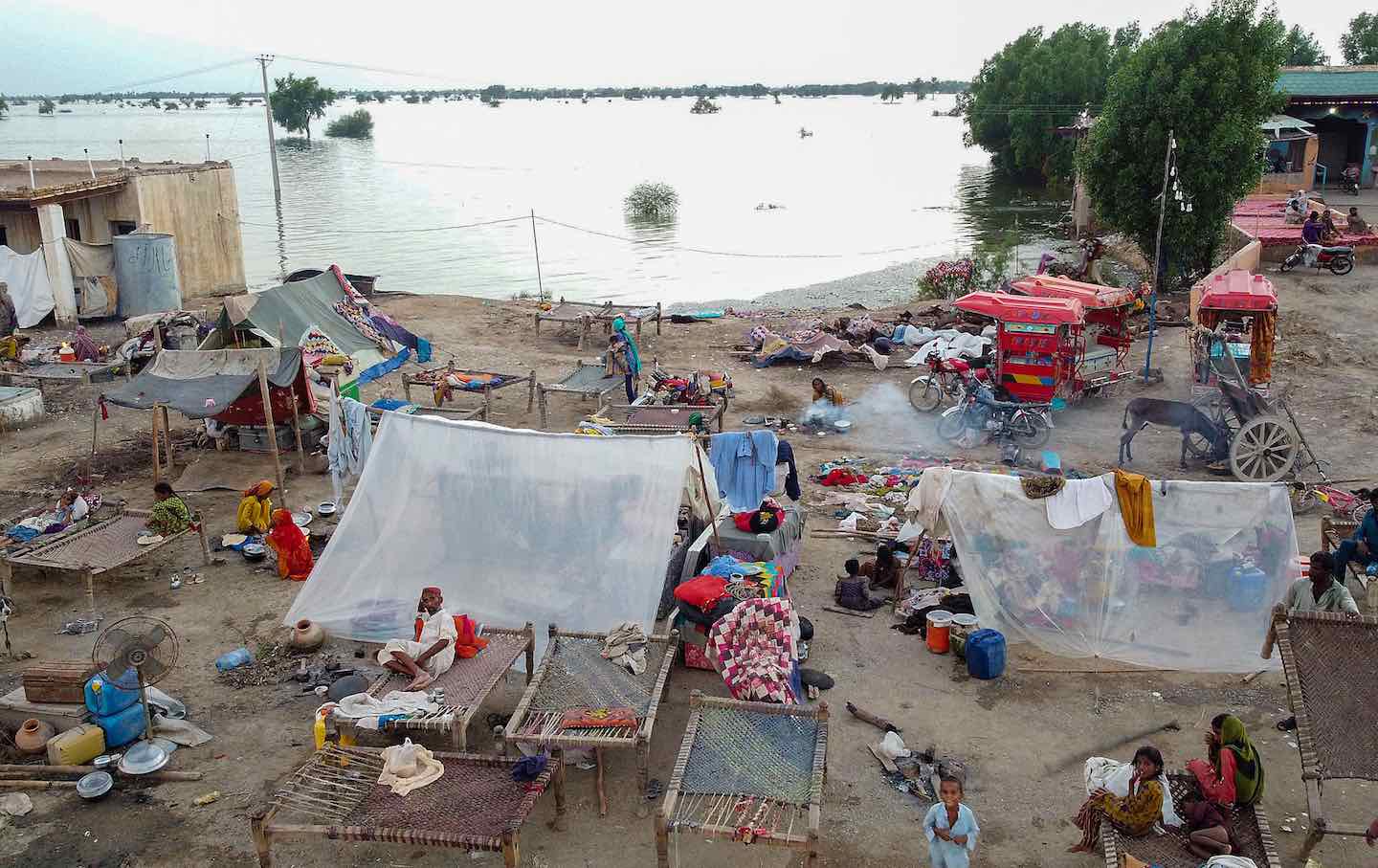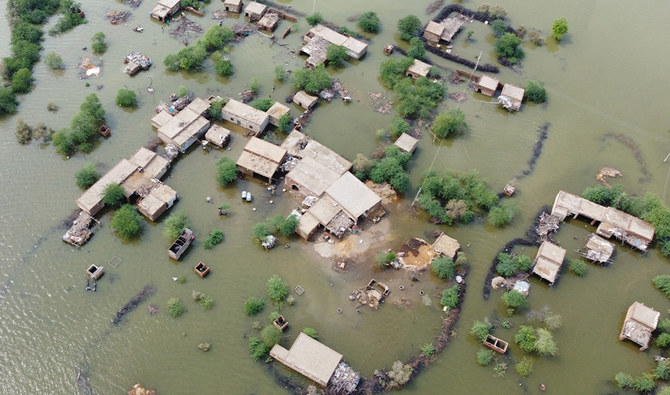Pakistan experienced two catastrophic floods in 2010 and 2022, affecting millions of people. From 1950 to 2011, Pakistan faced a flood every three years. These flooding events resulted in the death of 8887 humans and the economic loss of $19 billion1.
The 2010 super flood affected 0.2 billion people; 1985 people died, and the financial loss was $9.7 billion. The 2022 monsoon flooding resulted in the loss of 1033 lives, 5.4 million people displaced, 2 million acres of crops and 2 million homes destroyed, and 72 districts declared calamity hits.

Pakistan has negligible carbon footprint contributors but faces harmful impacts from climate change. According to the German watch Global Climate Risk Index (GCRI), for countries most affected by flood, Pakistan ranked at 8th position and is at 7th among countries vulnerable to climate change2.
The impact of floods on different areas of Pakistan varies according to their geographical characteristics, and measures are taken to manage disastrous effects. Punjab is the most populous and agriculturally productive province and often faces more destruction due to floods.
Floods in Punjab came because of heavy monsoon rainfall, overflow of rivers, and breaching of the canal system. The agricultural sector of Punjab causes the most destruction, resulting in crop loss and livestock mortality. The urban area faces infrastructure damage and disruption of network systems.
In Sindh, floods occur because of coastal and riverine flooding, destroying crops, mainly rice, sugarcane, and cotton. In Khyber Pakhtunkhwa and Gilgit Baltistan, another type of flooding was hit due to heavy rainfall and glacier melting. Floods in KPK destroy infrastructure, hinder relief efforts, and worsen poverty in already marginalized communities.
Balochistan eastern regions experience riverine flooding and occasional flash floods in its mountainous areas. Limited infrastructure development in these areas makes it challenging to provide immediate relief assistance and health care services to remote areas during floods.

Calamities like floods bring a lot of chaos in developing countries. The recent flood in Pakistan in 2022 resulted in the displacement of 33 million people3. Numerous IDP camps were established in affected areas to provide temporary shelter, food, and necessities to the displaced people. These camps were established in schools, open spaces, and government buildings to accommodate the influx of displaced people.
Temporary shelters like tents were provided to displace people, often overcrowded, poorly ventilated, and susceptible to flooding during heavy rainfall. Access to clean drinking water in camps has been limited, increasing the risk of waterborne diseases like hepatitis, Malaria, dengue, cholera, and skin infection4.
Poor waste management and drainage systems in camps result in an unclean environment, increasing health risks for camp residents. In overcrowded camps, there is a greater chance of the rapid spreading of infectious diseases. Healthcare workers, medicines, and medical supplies are often limited to camps.
In the 2022 flood, about 650,000 pregnant women lived in IDP camps,100,000 pregnant women were in Sindh,73,000 women had delivery dates of the next month, and they urgently needed skilled birth attendants, newborn care, and financial support. Women, children, and people with disabilities were vulnerable in IDP camps and faced abuse and negligence.
Affected People felt anxiety and depression as they lived in temporary shelters— and faced trauma due to the challenging situations during this whole disaster.
Climate change has increased the intensity of natural disasters like floood by changing weather patterns. Due to excessive human activities like burning fossil fuels, the earth’s temperature keeps rising. The likelihood of rainfall increases as warmer air holds moisture, leading to flooding.
The Karakoram and the Himalayas rely on glacier melting for their river water, used for agriculture, hydropower plants, and drinking. As the temperature surges, the melting of glaciers increases, leading to rivers. Deforestation, urbanization, and expansion of agricultural land increase the risk of flooding.
In Pakistan, flood management measures have been practiced since the establishment of the Federal flood commission in 1977. The provincial government deals with the execution of protective work, whereas the federal government deals with controlling funds while ensuring timely decisions5.
The government’s structural measures to control flood water are building dams, spurs, walls, and channels. Embankments prevent overflooding and spur stop soil erosion. To protect the irrigation network, villages, and towns, buns are made. Pakistan, being a riparian country, faces challenges in managing floods.
The Flood Forecasting Division of Pakistan’s Meteorological Department and the Water and Power Development Authority (WAPDA) are responsible for forecasting floods. Provincial irrigation and drainage authorities deal with river design, development, and maintenance. They also measure the discharge of rivers, canals, and drains to foretell floods and develop strategies in case of emergency.
The relief department at the provincial level is responsible for conducting surveys and ensuring the maintenance of bunds before flooding season. In 2018, a project known as the 10 Billion Tree Tsunami was initiated for the country-wide plantation of trees to combat global warming effects.
Climate change interacts with socioeconomic challenges and increases people’s vulnerability to these natural disasters. Several strategies can be implemented to make climate-resilient Pakistan transition to non-renewable energy resources— minimize Pakistan’s reliance on fossil fuels and reduce greenhouse gas emissions.
Create awareness among people about energy conservation. Promotion of climate-friendly agricultural practices like conservation tillage, crop rotation, agroforestry, and efficient irrigation techniques to increase agricultural production— and reduce the level of greenhouse gases produced by the agriculture sector.
Afforestation and deforestation reduce carbon dioxide levels in the environment and conserve biodiversity. Water conservation measures and rainwater harvesting techniques should be implemented. There must be a plan and an early warning system in case of any emergency so the community can cope with the consequences of natural disasters.
Promoting public transport can improve air quality is the need of time. We need to raise awareness among the people about climate change, its causes— and how it drastically affects our future generations.
Better and more efficient policies, regulations, and incentives should be implemented nationally and locally. Although Pakistan’s government is taking initiatives to mitigate climate change, more robust efforts are required to reduce climate change.
References:
- Ali, A., et al., Flood risk perception and communication: The role of hazard proximity. 2022. 316: p. 115309.
- Shah, A.A., et al., Gender perspective of flood early warning systems: People-centered approach. 2022. 14(14): p. 2261.
- Nanditha, J., et al., The Pakistan flood of August 2022: causes and implications. 2023. 11(3): p. e2022EF003230.
- Ashraf, M. et al., Understanding challenges women to face in flood-affected areas to access sexual and reproductive health services: a rapid assessment from a disaster-torn Pakistan. 2024. 2024.
- Tariq, M.A.U.R., Risk-based planning and optimization of flood management measures in developing countries: Case Pakistan. 2011.
Also Read: Let’s heal the Earth to unleash the power of earning a better livelihood
Haleema Javed is an MPhil student at Forman Christian College in Molecular Pathology and Genomics. She completed his BS in Biotechnology from Forman Christian College. She likes reading books.

